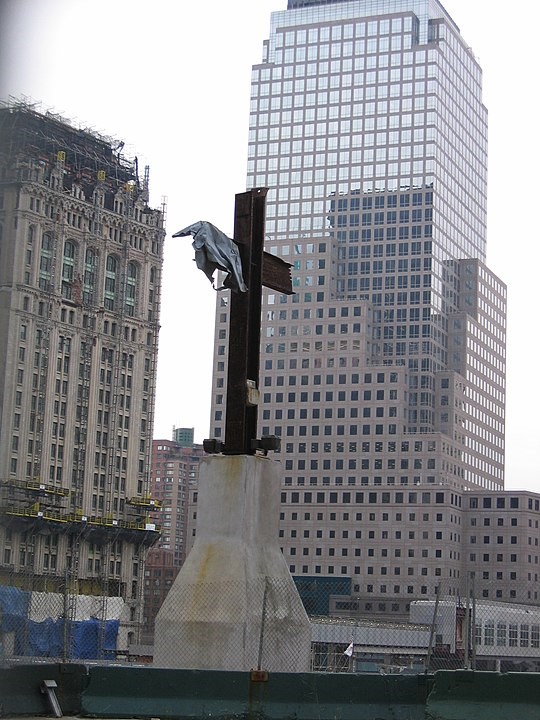Raised and Raising at Ground Zero
The Friday Reflection by James M. Kushiner
November 20th, 2020

O
n September 13, 2001, rescue workers recovered three bodies from Ground Zero, site of the September 11 terrorist attack on the World Trade Center. They had held faint hopes of finding survivors, and failed. The nation was reeling from trauma. While surveying the smoldering ruins later that evening, one of the exhausted rescuers, Frank Silecchia, was startled to see a large iron cross standing upright in the pit. "It dropped me to my knees in tears," he later recalled.
Three weeks later, New York Mayor Rudy Giuliani had the massive cross moved by crane and installed on a large pedestal on Church Street near Liberty, where it remained for five years and became known as the Ground Zero Cross, a place of prayer and spiritual consolation for many, including the families of the victims.
Remarkably, on September 13, 2001, my parish and other churches in the U.S. had observed Vespers for the Feast of the Universal Exaltation of the Precious and Life-Giving Cross—the evening the Cross was found at Ground Zero. This feast has been observed annually since the fourth century, and begins with Vespers the evening before September 14.
The discovery of an iron cross standing upright in the ruins of the World Trade Center on the Feast of the Holy Cross almost sounds too good to be true, like a medieval miracle tale moderns chalk up to overly pious imaginations and gullibility. Five hundred years from now, will scholars and their students say that the Legend of the Cross at Ground Zero was a popular pious fiction that helped distraught people cope with trauma at time? Yet it happened—an iron Cross appeared upright in the ruins—on the Feast of the Holy Cross.
The origin of the Feast of the Holy Cross itself is assumed by many to be based on a pious fiction. Instituted in the fourth century, the feast commemorates, among other things, the discovery of the True Cross of Christ in Jerusalem by Helena, mother of the Emperor Constantine. The Cross was said to have been found buried in the rubble from various building projects when the city was enlarged at the time of Emperor Hadrian. As one of the Orthodox Vesper hymns sung on September 13 puts it, the newly-found cross is a "Divine treasure, hidden in the earth."
Today, we look back over a thousand years to this story of Helena's discovery, an event in the distant past. She, too, had to look back, for the Cross that she sought in the fourth century was also a relic from something that had happened nearly 300 years earlier, the Crucifixion of Christ.
Like Helena, we know the truth of the Crucifixion through our Gospel eyewitnesses, the basis for the fourth-century confession of faith that nails the event to real history: "suffered under Pontius Pilate," the Roman procurator of Palestine in AD 33, as recorded in all four Gospels. There is no serious dispute over the Crucifixion of Jesus of Nazareth ever taking place.
His Crucifixion was one of many crucifixions that took place in a public place set aside by the Roman government for the execution of criminals. The Christian residents of Jerusalem of the fourth century kept alive the memory of the place of the Crucifixion (as well as the Tomb of Christ). The local Christians knew well the location of that unforgettable public event central to their Faith, originally outside the City walls.
The Cross will never perish from the earth. At the end of time, the nations will look upon him whom they pierced. The scars from the nails are signs in the Resurrected Body of Christ. The Cross is a sign of victory, a consolation in times of trouble. As John Chrysostom, the patriarch of the city founded by Helena's son, Constantine, put it years later:
"When a Christian crosses himself, he is proclaiming Christ's victory over death and the Devil...The Cross has put death to death, rased to the ground the Devil's fortress...and delivered the whole world which was under condemnation."
I'd say it's a good time to think about using the sign of the Cross more often, including in public—you can't get much more public than a World Trade Center.
Yours for Christ, Creed & Culture,

James M. Kushiner
Executive Director, The Fellowship of St. James
—James M. Kushiner is Executive Editor of Touchstone: A Journal of Mere Christianity, and Executive Director of The Fellowship of St. James.







